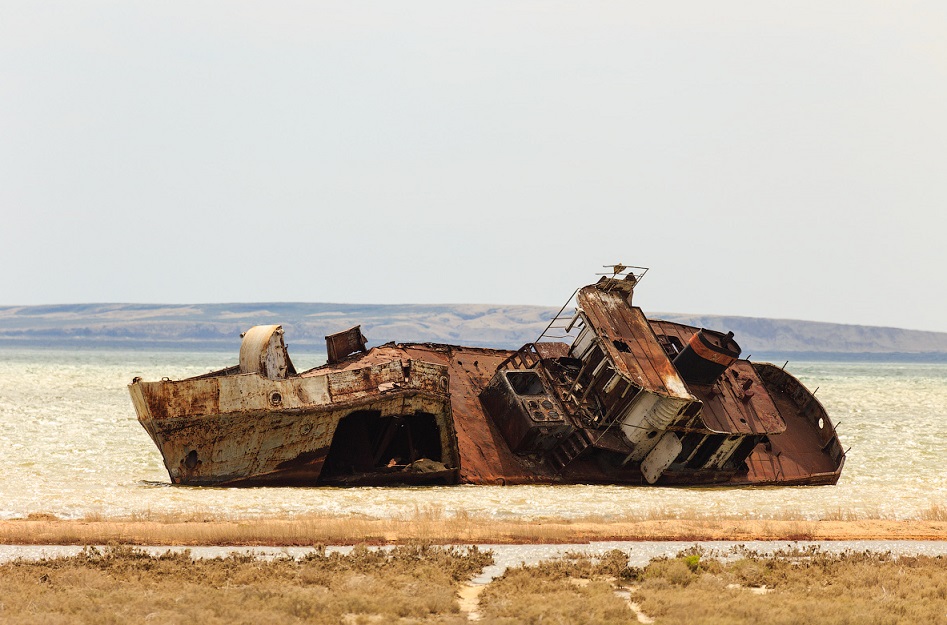Turkmenistan renewed its commitment to help countries affected by the ecological disaster in areas surrounding the Aral Sea, with officials and ecology experts gathering in the capital of Ashgabat this week for a conference centered on the International Fund for Saving the Aral Sea (IFAS).
“Our state, together with the countries of Central Asia, plans to prepare a new program of assistance to the countries of the Aral region,” Turkmenistan’s President Gurbanguly Berdymukhamedov said while addressing conference participants on Monday.
The conference, headlined “The role of IFAS in the development of cooperation in the Central Asian region,” brought together representatives from the Organization for Security and Co-operation in Europe (OSCE), the United Nations Development Program (UNDP), the UN Regional Center for Preventive Diplomacy for Central Asia, the World Bank and Asian Development Bank, as well as other countries lying within the Aral Sea basin and IFAS member states, namely Kazakhstan, Tajikistan, Uzbekistan and Kyrgyzstan.
Over the past 40 years the Aral Sea, which once occupied a territory of more than 60,000 square kilometers on the border between southwestern Kazakhstan and northwestern Uzbekistan, has all but completely dried up. Once the fourth largest lake in the world after the Caspian Sea, the Upper Lake in North America and Lake Victoria in East Africa, today the Aral Sea’s surface area measures 17,160 square kilometers (6,626 square miles), or just 10 percent of its original volume.
The two largest rivers in Central Asia, Syr Darya and Amu Darya, used to flow into the Aral Sea and were its main water sources. Soviet leaders wanted to turn Central Asia into the world’s largest cotton producer, and used the waters of the rivers to irrigate fields in countries like Uzbekistan, whose cotton industry was at the top in the 1980s. Over time, most of the Amu Darya’s waters began to sink into Uzbekistan’s cotton fields, never reaching the Aral Sea. In a bid to create a successful cotton industry, Soviet authorities also destroyed the sea’s fishing industry.
Over time, the sea split into two salt lakes: the South Aral Sea, or “Large Sea,” mainly within Uzbekistan’s borders, and the North Aral Sea, also called “The Small Sea,” in Kazakhstan.
As the sea’s waters continue to dry up, the climate in the region has become more arid. Winters have become colder, with temperatures dropping by one to three degrees Celsius. The region suffers from annual windstorms, which carry up to 75 million tons of salt containing large quantities of chemical fertilizers and pesticides that were used in agriculture and washed away from fields into rivers and then into the sea. The salt desert of Aralkum, once forming the seabed, experience intense wind storms, with trails of salt and dust measuring between 200 and 300 kilometers.
Despite a grim outlook, Central Asian states are involved in efforts meant to raise the sea’s water levels. Kazakhstan, for example, has allocated $85 million for the construction of the Dike Kokaral dam, which runs along the narrow stretch of water separating the North Aral Sea from the South Sea. Dike Kokaral is designed to conserve water flowing from the Syr Darya river while attempting to revive the ecology of the North Aral Sea.
Earlier this year Uzbekistan, together with the United Nations, launched a program aimed at improving the standard of living for populations inhabiting rural areas around the Aral Sea, as well as assisting people with adapting to climatic changes and promoting efficient uses of natural resources.
Starting this year Ashgabat chairs the IFAS, an organization created by the Central Asian countries in 1993 in a bid to overcome the ecological crisis and improve the basin’s socio-economic situation.
Turkmenistan, a country that lies within the Caspian basin and covered largely by the Karakum Desert, is seen as a source of support and technical expertise in water usage and conservation. Ashgabat implements a range of projects that are related to what Uzbekistan and Kazakhstan face with regards to the Aral Sea, including the construction of water treatment plants meant to provide clean drinking water. It also maintains an artificial lake, named “Altyn Asyr” or the Golden Age Lake, which is designed to collect mineralized waters from farmland.
“This project, unprecedented in its scale, is of great importance not only for Turkmenistan, but for the whole of Central Asia, as it will have a beneficial effect on the ecology of the region,” the Neutral Turkmenistan newspaper reported in 2016.







 The number of evacuees from flooded areas in Kazakhstan has reached 97,852 people, including about 32,856 children since March 27.
The number of evacuees from flooded areas in Kazakhstan has reached 97,852 people, including about 32,856 children since March 27.
 The Islamic holy month of fasting, Ramadan comes to an end this week with the celebration of a joyous festival called Eid (meaning “festival” in Ar...
The Islamic holy month of fasting, Ramadan comes to an end this week with the celebration of a joyous festival called Eid (meaning “festival” in Ar...
 Iran's senior military leaders described the drone and missile attack on Israel on April 14 night as “successful".
Iran's senior military leaders described the drone and missile attack on Israel on April 14 night as “successful".
 Iranian President Ebrahim Raisi warned Israel that it would face a "real and extensive" response if it makes any "mistake" following Tehran’s missi...
Iranian President Ebrahim Raisi warned Israel that it would face a "real and extensive" response if it makes any "mistake" following Tehran’s missi...



